| Cook
Forest cooks |
Robert
Leverett |
| Nov
21, 2005 05:53 PST |
ENTS,
On Friday, my partner Monica Jakuc
and I headed to Cook Forest
State Park, PA to join up with our great friend park naturalist,
educational director, and Ent extraordinaire Dale Luthringer
with the
expressed purpose of volume modeling the Seneca, Cook, and
Longfellow
pines. Dale had secured us a cabin courtesy of DCNR to stay in
on Friday
and Saturday nights. The weather at Cook, though very cool, was
splendid
throughout the weekend. And despite a lingering sinus infection,
I felt
highly energized once Monica and I reached Cook forest. After Monica
and
I got settled in our cabin, we joined Ed Frank and Dale for
dinner at the
Trail's End. A table of people close by who were celebrating
made
hearing what each of us was saying nearly impossible. But we
still had
fun. However, they had been working with a downed cucumber
magnolia near
the Longfellow pine. Ed was sure its age would exceed the oldest
known
cucumber and it turns out he was right. I'm sure Dale will have
the full
story, but the tree based on three counts by Dale is not less
than 450
years old! That extends the maximum recorded age for the species
by
nearly 100 years. Cook Forest has many very, very old trees.
Well, on Saturday, we met at the
Log Cabin. Dr. Gordon Whitney,
forest ecologist and historian, formerly with Harvard Forest
joined us.
That was a real treat. Gordon's book "From Coastal
Wilderness to Fruited
Plain" is a classic. Unlike Tom Bonnicksen's overt biases,
Gordon
remains scholarly throughout. Tony Kelly and Carl Harting also
joined
us. It was a fun group. Everyone was enthralled with the forest.
We went first to the huge Cook
pine. At 12.4 feet in circumference
and 161.5 feet in height, the tree that honors the Cook family
is one of
the remaining standing giants. It modeled out to a slightly low
number
of 838 cubes. I suspect that it is closer to 850, but for now,
838 is
the number. Incidentally, the Thoreau pine in Massachusetts is
12.6 feet
in circumference and now about 160.8 feet in height and it cubes
out to
855. So the volumes are quite comparable for the respective
heights and
circumferences.
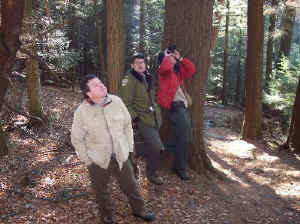
Anthony Kelly, Dale Luthringer and Gordon Whitney at
the Longfellow Pine - photo by Carl Harting |
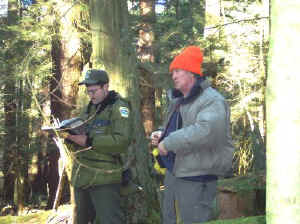
Dale Luthringer and Bob Leverett model the Seneca
Pine in Cook Forest. - photo by Carl Harting |
After the Cook pine we modeled a
huge hemlock and named it after
Gordon Whitney. The hemlock modeled out to 704 cubes. It's CBH
is
exactly 12 feet. Believe it or not, I actually forgot to get a
full
height on the tree, but guessed its height to be 128.7 feet.
Don't try
to understand why exactly 128.7. There's an inside joke there.
We proceeded from the Whitney
hemlock to the giant Seneca pine.
What a marvelous tree! At 12.5 feet in circumference and 173.2
feet in
height, the Seneca pine competes with the Cornplanter pine as
PA's
official state champion. However, our task was to volume model
it and we
came up with 955 cubes. However, I had inadvertently failed to
include
the base to 2.5-foot section. The final number is 978 cubes. I
honestly
believe that it Seneca pine matches the Grandfather tree in
Monroe State
Forest, but will need to get more readings off the Grandfather
tree,
which I suspect has strongly elliptical sections that will
reduce its
volume to around 1000 cubes.
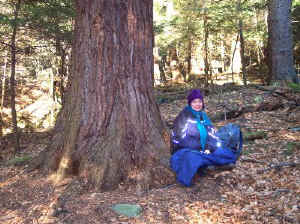
Monica Jakuc sitting by the Monica Jakuc Hemlock
while the Longfellow Pine was being modeled - photo by
Carl Harting |
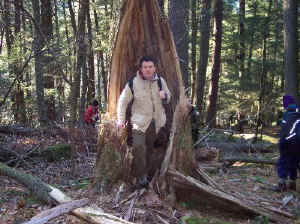
Anthony Kelly standing inside the hollow base of a
fallen 400+ year old cucumber tree in Cook Forest -
photo by Carl Harting |
We went from the Seneca pine to
the Longfellow, where we remeasured
the great pine's height. It is a much slimmer tree than the
first two,
so I was not expecting anywhere near as much total volume and
there
isn't. We got 606 cubes. However, the Northeast's tallest tree
has
reached 182.5 feet.
We modeled 3 smaller pines to add
to the data set being used to
develop a regression equation. Including the new pines and
running the
regression produced a multiple linear regression of 0.959.
However, the
regression equation still underestimates volume at both the high
and low
ends of the range of tree sizes that make up the data set. One
size will
not fit all. A Lot more analysis has to be done, but we're much
farther
along than we were.
Bob
Robert T. Leverett
Cofounder, Eastern Native Tree Society
|
| Re:
Cook Forest cooks |
Edward
Frank |
| Nov
21, 2005 07:29 PST |
ENTS,
Friday I went to Cook Forest top look at the cucumber cookie
Dale had
collected from a large fallen Cucumber Tree. The tree is the
same one
pictured in a photo by Will Blozan from the spring Rendezvous.
Dale had
suggested in other communications that he tree was in excess of
300 years
old. Neil Pederson from EKU posted on the list last week
"The oldest
cucumbertree to date that I am familiar with is one I cored in
central
Virginia. Myvonwynn Hopton and I dated it to 348 years. This was
cored back
in 2003. So, it will be 350 years old today if it is still
alive." Based
upon looking at the tightness of the rings, the size of the
cookie, and some
preliminary counting I am convinced the tree is in excess of the
350 year
age. The cookie still needs to be sanded and polished, but that
is Dale's
plan for later this winter and I will leave that to him. I would
also like
to measure the widths of the individual rings to document the
history of the
tree.
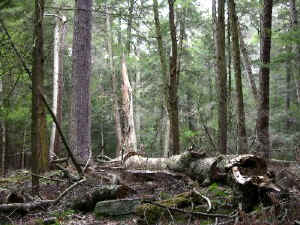
Photo of the fallen cucumber tree - photo by Ed Frank
Then Dale and I went to look at the fallen tree. It is
located near
the intersection of the Longfellow Trail and the Red Eft Trail.
He went
back to work and I stayed and measured circumferences/diameters
at various
points along the trunk to use to determine the volume of the
trunk of the
tree. I also took a number of photos as an initial starting
point to
document over time the various stages and organisms involved in
the eventual
decay of the fallen giant. It will be interesting if I can
return in ten
years and see how the fallen tree has fared over the years.
Does anyone have a photograph of the tree prior to its demise?
That evening Dale and I met up with Monica Jakuc and Bob
Leverett for dinner
at the Trails End Restaraunt - even if Bob doesn't remember my
name.
Unfortunately I had to work and missed the Saturday measuring
fest.
Ed Frank
|
| RE:
Cook Forest cooks |
djluth-@pennswoods.net |
|
Nov
21, 2005 07:45 PST |
Bob,
Thanks again for coming all the way over to Cook Forest. It is
always a
pleasure to have you over. It was also nice to see Monica again
(you've
got a gem there, Bob). It was a real treat to have Gordon drop
in
Saturday too. Then, when you throw in budding old growth/big
tree
researchers Carl Harting and Anthony Kelly, it turned out we had
a
pretty good crew on hand for trunk modeling.
Yes, the weather was great, but I don't think we can take away
your "Low
Pressure Leverett" nickname just yet... my wife had about
8inches of
snow up in Erie, so I think we just happened to be lucky this
time.
978 cubes for the Seneca Pine is not too shabby. With what we
found the
Cook and Seneca Pines to be, I'm still thinking around
~1000-1050 cubes
for the Cornplanter. Looks like that'll have to wait for the
next trip.
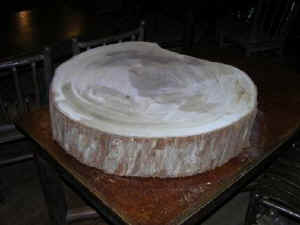
That cuke' cross section is impressive. Because the base was
hollow the
"cookie" was taken at 22'2" up the trunk from its mid-slope
base. I counted 425,
427, and 433 rings, but I need to sand it down better. Maybe I
could
get Marc Abrams to take a run down to Cook sometime this winter
and take
a better look at it. I have a tough time determining false
rings, and
am not sure how prevalent cucumber magnolia are with this
phenomena.
Well Ed, you were right, it looks like I was a little too
conservative
on my earlier age estimate.
|
| RE:
Cook Forest cooks |
Robert
Leverett |
| Nov
21, 2005 10:29 PST |
Ed,
I would bet that there is a scattering of very
old trees in Cook
Forest that predate all the dendro work that has been done to
date. What
the distribution would mean, I don't know. But I believe it is
there.
Bob
|
| Monica's
Hemlock |
Carl
Harting |
| Nov
21, 2005 19:02 PST |
As we began to model the Longfellow Pine at Cook Forest on
Saturday
afternoon Monica Jakuc walked straight to an old hemlock located
just up
the drainage and took a seat at its feet. She told me that
according to
Lee Frelich this very old tree was possibly the seed source for
many of
the other hemlocks in the area and holds a special place in her
heart.
Monica was kind enough to allow me to photograph her as she
communed
with the tree and I've forwarded the photo to Ed Frank. I would
like to
propose that this tree be named the Monica Jakuc Hemlock in her
honor.
Dale, does this sound okay to you? |
| RE:
Monica's Hemlock |
Robert
Leverett |
| Nov
22, 2005 06:22 PST |
Carl,
Thanks for taking the lead on this. I second
the proposal. Monica has
earned an important place in ENTS with the first ENTS concert
that she
organized and held this past October 15th. She will continue to
be a
visible mover and shaper of ENTS events and spirit. This comes
from her
own inner spirit as opposed to her role as my partner. Monica is
obviously very connected to trees and she quickly responds to
their
individual personalities, seeking to explore aspects of their
uniqueness. Monica had talked about revisiting the hemlock on
the way to
Cook. It became a very special tree to her on her first visit to
Cook. I
look forward to when she will have more time to post and share
her
perceptions about trees to her. At present, Smith College is
hiring an
assistant to her and she's swamped with interviews, committee
meetings,
etc. That will soon change.
On our way home, Monica requested that on our
next visit to Cook that
we plan to stay several days. She felt cheated from the short
amount of
time we spent walking among the great trees. She wants to
commune with
many of the great trees, sense the moods of the forest, read
poetry, and
meditate. I agreed. Our next visit will be for several days.
If Dale agrees to the naming, Monica will be
the second lady in Cook
Forest with a tree named for her. The first is the Jani tree
named for
my dear wife Jani who passed away on Dec 30, 2003. It is fitting
that
the great trees of Cook Forest be blessed with female spirit and
energy.
That is needed as a balance to the male energy.
Bob
|
| RE:
Monica's Hemlock |
Monica
Jakuc |
| Nov
23, 2005 12:45 PST |
Dear Carl,
I've been off-list for a few days getting caught up at school.
Thank
you for your very sweet idea. I would be most honored to have
that tree
named for me. It is a great mother in its spirit.
It was great to see you again, and to spend time in the woods
with you.
Cook Forest is such a treasure.
Monica
|
| RE:
Cook Forest cooks EXCELLENT! |
Will
Blozan |
| Nov
22, 2005 06:38 PST |
Oh Thy brethren endowed with big Pinus,
Excellent stuff you guys (and gal)! We seem to be honing in on
the white
pine size maxima for what we have left. I suspect the pines in
Wisconsin and
Michigan were substantially larger, but by how much?
Bob, do the volumes you present include a limb estimate? As I
mentioned
before I think the estimate should be dropped entirely. We ENTS
take such
great care and precision in our measurements that introducing an
estimate
based on nothing but speculation undermines our efforts. What do
you think?
The Zahner Pine which Jess and I will report on soon looks like
it will be
close to 1100 cubes in just the trunk. I am going to try to find
a photo of
a huge pine in Mill Creek, TN that may be close in volume.
Michael Davie may
have a photo of it as well.
Good times ya'll! ENTS rules!
|
| Trunk
minus limbs |
Robert
Leverett |
|
Nov
22, 2005 07:38 PST |
Will,
I suspect you are right. Ed Frank has
basically suggested the same
thing. My limb volumes are just estimates, anywhere from 5% to
7% of
trunk volume. I usually set the percentage at 6% to reflect more
of the
total mass of the organism, but limb inclusion is a weak link
calculation. I can drop it out very easily.
Without limbs, the lineup of the biggest pines
we have modeled up
this way with volumes of 750 cubes or more are as follows:
Grandfather Tree: 1028
Ice Glen Pine:
960
Seneca Pine:
919
Grandmother Tree: 863
Hiawatha:
808 (Multiple trunks)
Thoreau:
802
Conway:
789
Cook:
788
Bullard:
760
There are 6 or 7 more large pines that remain
to be modeled, but I
doubt that any of the single-trunked ones will reach 800 cubes.
I will
remodel the Grandfather pine a third time. This time I will
insure that
the largest dimensions don't shrink when I shoot them from 90
degrees
around the trunk. If the Grandfather tree is a legitimate
1000-cuber, we
need to verify it. I'm guessing that it is as I believe are the
Tamworth
and Cornplanter pines. But overall, the 1000-cubers are scare as
hen's
teeth.
Bob
|
| Reflections
on modeling |
Robert
Leverett |
| Nov
22, 2005 09:53 PST |
Will, Jess, Lee, John, Ed, Carl, et al:
The smallest pine we modeled at Cook came to 77.6 cubic feet of
trunk
(only) volume. The Seneca has 919 cubes of trunk volume. The
ratio of
the volumes of the Seneca to the small pine is a hefty 11.8 to
1. At
only 18 inches DBH, the small pine is a surprising 123 feet
tall. The
ratio of DBHs is 2.6 to 1 and the ratio of heights is 1.4 to 1.
I am unsure of what the perceptions are among
timber specialists
about representative amounts of added volume pines can acquire
from
early dimesnions of 18 to 20 inches DBH and 100 to 120 feet up
to a
typical full size or to the behemoth size of the Seneca.
Interestingly,
the small pine was not all that young. It grew in less than
ideal
conditions.
A young equivalent of the small Cook pine is
the one I modeled on Mt
Tom to a mere 55 cubes of trunk volume. That tree is right at
100 feet
tall and 16 inches DBH. The ratio of the Seneca pine's volume to
that of
the slender young Mt Tom tree is 16.7 to 1.
Beyond what they obviously show, I'm unsure of
how to treat these
ratios, i.e. what conclusions they point toward. At this point
it is
just interesting to fiddle with the numbers.
Bob
Robert T. Leverett
Cofounder, Eastern Native Tree Society
| RE:
Monica's Hemlock |
Monica
Jakuc |
| Nov
23, 2005 12:45 PST |
Dear Carl,
I've been off-list for a few days getting caught up at
school. Thank
you for your very sweet idea. I would be most honored to
have that tree
named for me. It is a great mother in its spirit.
It was great to see you again, and to spend time in the
woods with you.
Cook Forest is such a treasure.
Monica
Carl Harting wrote:
| |
As we began to model the Longfellow Pine at Cook
Forest on Saturday
afternoon Monica Jakuc walked straight to an old
hemlock located just up
the drainage and took a seat at its feet. She
told me that according to
Lee Frelich this very old tree was possibly the
seed source for many of
the other hemlocks in the area and holds a
special place in her heart.
Monica was kind enough to allow me to photograph
her as she communed
with the tree and I've forwarded the photo to Ed
Frank. I would like to
propose that this tree be named the Monica Jakuc
Hemlock in her honor.
Dale, does this sound okay to you? |
|
|
| RE:
Monica's Hemlock |
djluth-@pennswoods.net |
| Nov
29, 2005 10:42 PST |
Carl, Monica,
It is now official. From this point henceforth, that particular
hemlock
will now be called the 'Monica Jakuc Hemlock'.
Dale
|
| Re:
ENTS list membership |
Kirk
Johnson |
| Dec
05, 2005 21:38 PST |
Congratulations
Dale & other ENTS on this nice article about the Cook Forest
trees!
The WTO is my local paper. Good article to read over this
morning's
breakfast!
Kirk Johnson
Warren Times Observer
Monday, December 5, 2005
Big trees at Cook Forest among timber giants
By MATT EWALT Staff Writer
They are the giants of the old-growth forest, towering above
other trees
born centuries ago. Hundreds of miles from the titans of the
Great Smoky
Mountains, the white pines in Cook Forest State Park have long
been known
for their record-setting size.
On Nov. 19, a team of ecologists, naturalists and researchers
spent the day
in Cook Forest using the latest technology to document three of
Pennsylvania's largest white pines.
"These big trees are really the main reason why we have the
park," explained
Dale Luthringer, environmental education specialist for Cook
Forest State
Park.
"The Cook family worked this area for close to 80 years,
and saved a large
tract of land behind their house," he said. Now,
approximately 2,100 acres
of old-growth areas, with some of the largest white pines in the
eastern
United States, are a popular tourist destination.
Last month's 'trunk modeling' was headed by Robert Leverett,
co-founder and
executive director of the Eastern Native Tree Society (ENTS).
The non-profit
group has developed state-of-the-art research techniques for
measuring
trees.
Leverett and his team are conducting a study of tree volumes in
terms of
cubic feet, using a new laser device, the RD1000.
"We normally look at trees in terms of board feet, or what
we're going to
use out of that tree," said Luthringer. "But this
takes into account the
wood that we don't normally use."
Researchers use an infrared laser-based tool to measure the
height of the
tree and also measure the girth, or circumference at base
height, a
dimension taken at a point 4.5 feet above the ground.
The information collected on noteworthy trees in Cook Forest
State Park will
then be compared to other large pines and conifers measured
throughout the
northeast and shared with scientists working in the southern
United States,
around the Great Smoky Mountains.
--
At close to 350 years old, Cook Pine stands proudly on a hilltop
in the Cook
Forest, sticking out above the crowns of the surrounding trees.
Due to
centuries of wind damage, many of the limbs have grown in
twisted shapes.
"It almost looks like it has two arms reaching up to the
sky," said
Luthringer.
The Cook Pine is one of the largest white pines in overall
dimensions
statewide, with a circumference of 12 feet and a height of 161.7
feet.
"We have a very hard time finding forest-grown trees in
northwestern
Pennsylvania that break 12 feet in circumference regardless of
any species,"
said Luthringer. "Out in the field or someone's front yard
they grow fatter,
but not that high."
In fact, researchers have cataloged 27 pines with a height of
160 feet or
greater in the Cook Forest State Park.
Only three other pines of that size are found in the rest of
Pennsylvania.
Seneca Pine, the "State Co-Champion White Pine,"
measures 12.5 feet in
circumference and 173 feet high. It is the second largest White
Pine in
overall dimensions and is likely as old as Cook Pine.
"There are only three trees taller than 170 feet in Cook
Forest," said
Luthringer. "We've been on a lot of wild goose chases, but
haven't been able
to document any others in the Northeast."
"Down in the Smokies, it is more common, but is still very
hard to find," he
said.
And then there is the The Longfellow Pine, the tallest known
tree in the
Northeast and the fifth tallest in the entire eastern United
States. It
measures 11.1 feet in circumference and 182.5 feet high.
"There are maybe six or seven white pine measured above 183
feet in the
entire United States," said Luthringer.
--
Luthringer is also participating in a study led by Dr. Lee
Frelich, director
of hardwood ecology at the University of Minnesota. Frelich is
examining
patterns in tree height in terms of latitude, altitude, and the
growing
season.
Common sense dictates that the longer the growing season, the
bigger and
taller the tree. That's why many of the largest white pines in
the eastern
United States can be found in the Great Smoky Mountains.
But why so many record-breakers here in northwestern
Pennsylvania?
"I think a lot of it has to do with forest practices,"
said Luthringer.
"With most of the land, we don't wait 200 to 250 years to
harvest."
"In Cook Forest, there was a large section of the forest
that was left
untouched by the Cook family," he said. "Most of the
rest of the state was
largely cut over by the early 1900s."
"There are many old pockets of old growth," he said,
"but very few remaining
old growth pockets of white pine."
After measurements were taken at Cook Forest, Warren County's
Cornplanter
Pine, located within the Anders Run Natural Area, retained its
title as
largest known white pine in Pennsylvania.
Previously measured at 13 feet in circumference and 167.1 feet
in height,
Luthringer said the ENTS team will likely measure the
Cornplanter Pine in
the spring. |
|